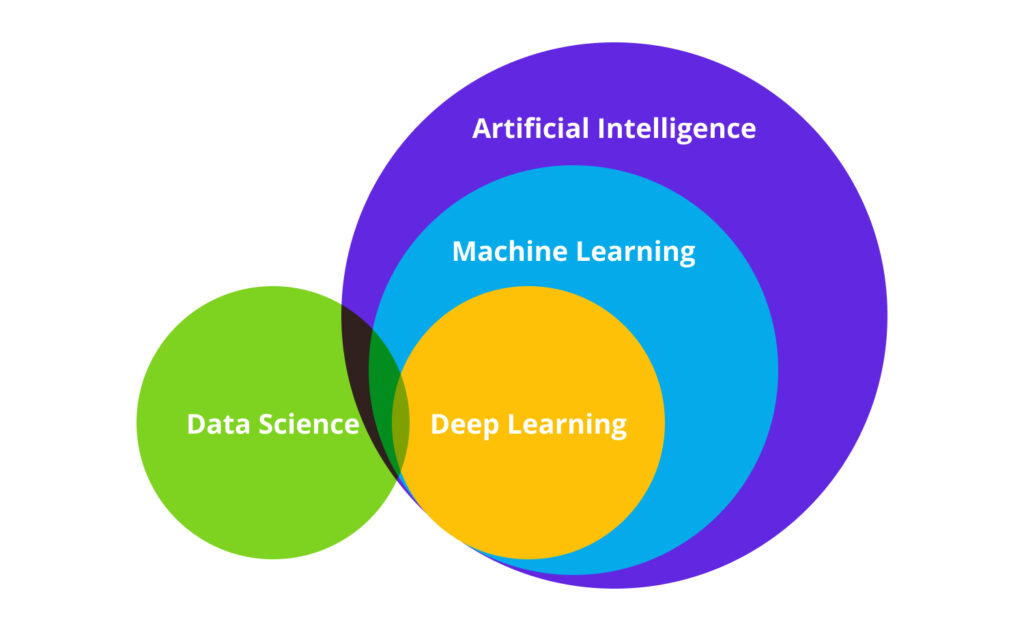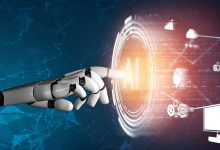Author: Volnyanskyi A.
Many people consider the terms “artificial intelligence” and “machine learning” to be synonymous, but this is not the case. We explain how these two technologies differ and how they are used both separately and together to solve various tasks.
There are several definitions of these technologies, but we will choose those that best highlight the differences between them.
- Definition of Artificial Intelligence
- Definition of Machine Learning
- What links AI and ML?
- What are the differences between AI and ML?
- Joint Use of AI and ML
Definition of Artificial Intelligence
Artificial Intelligence (AI) is specialized software that mimics human cognitive abilities to perform complex tasks, namely the ability to learn, reason, and analyze information. Like humans, AI can make decisions, translate texts, analyze historical data, and much more, previously only capable by human thought. In other words, artificial intelligence can be described as a set of software tools that make computational machines behave intelligently like humans.
At the same time, a significant portion of artificial intelligence tasks are performed using machine learning.
Definition of Machine Learning
Machine learning (ML) is a type of artificial intelligence that uses the results of training on datasets to create models capable of performing complex tasks. Instead of programming, ML uses algorithms to analyze data, learn from it, and make informed decisions. As the training progresses and more data is used, the algorithms become increasingly accurate, meaning the more data used in the process, the better and more efficient the model becomes.
In many cases, machine learning programs are provided with large amounts of input data (such as images, texts, messages), within which they find common patterns and identify regularities. This method of machine learning is called “supervised learning.” There are also other approaches: “semi-supervised learning,” “unsupervised learning” (also known as “unsupervised training”), and “reinforcement learning.”
What links AI and ML?
From the definitions, it’s clear that machine learning is a subset, one of the components of artificial intelligence; that is, they are distinct but closely related. AI is a broader concept that defines the ability of a computer system to think, reason, and act like a human. At the same time, ML is one of the areas within AI that allows a computer system to learn from data and make decisions based on the results of that learning. In addition to ML, the concept of AI also includes deep learning, robotics, natural language processing (NLP), and other fields.
The interconnection of artificial intelligence with machine learning and other disciplines is vividly represented in this diagram:

How else do artificial intelligence and machine learning intersect?
- Guided by data: AI uses it to make informed decisions, while ML uses it for training and modeling.
- Automation: Both technologies ultimately allow for the automation of tasks that are typically performed by humans.
- Continuous improvement: The more data AI and ML have at their disposal, the more accurate their results will be.
- Resource demand: Both technologies require substantial computational power.
What are the differences between AI and ML?
The main difference is that machine learning does not in any way simulate human intelligence, but rather focuses on identifying patterns in data. ML has a narrower, more specific area of application: creating predictive models, whereas AI has a much broader range of possibilities for use in solving a variety of tasks.
Additionally, the differences between ML and AI are expressed in the following:
- End goals: AI aims to mimic human intelligence, while ML focuses on learning from data to provide accurate predictions.
- Learning process: For AI, learning is not mandatory, unlike ML where the learning process is continuous.
- Data requirements: ML requires structured data for training, and this property is crucial for the accuracy of predictions, whereas AI has varying data requirements depending on the task’s specificity and the complexity of the algorithm.
- Human involvement: In AI, humans often set specific rules and manually tune the intelligent system, whereas in ML human intervention is minimal (maximizing automation of operations).
- Output data: In AI, the outputs vary significantly depending on the specific task, while in ML, they are usually numerical data or classifications.
Joint Use of AI and ML
In some tasks, it indeed makes sense to use both artificial intelligence and machine learning. For example, this can have a specific effect when it is necessary to:
- Analyze large volumes of structured and unstructured data;
- Reduce the number of errors caused by human factors;
- Ensure faster and more accurate data-based decision-making;
- Integrate predictive analytics into business processes.
The implementation of artificial intelligence and machine learning allows companies to rethink the benefits of data and learn how to use it to enhance efficiency, improve decision-making processes, and the quality of customer service.
Colobridge’s Expert:
“Although machine learning is essentially a component of artificial intelligence, it is entirely accurate to talk about their combined use. We often see the combination of machine learning and artificial intelligence in various fields. For example, in healthcare, this can be analyzing medical data of patients, predicting treatment outcomes, and accelerating the development of new drugs. In manufacturing — monitoring equipment and identifying potential future problems, increasing operational efficiency. In retail — predicting demand, compiling personalized recommendations. And in fintech — analyzing risks, detecting fraud cases. In each of these instances, both AI and ML have their roles, and they can also work with other disciplines — for example, mathematical statistics and analytics.”
If your organization is just planning to implement AI into its business processes, you need a reliable technology partner with relevant expertise and experience — this will help reduce initial costs and achieve results in the near future. Find out at Colobridge which solution will best meet the needs of your business and what computing resources are necessary for it.





